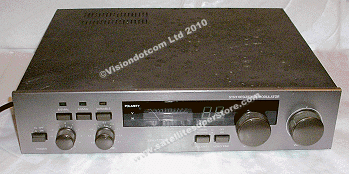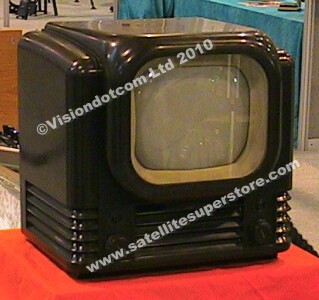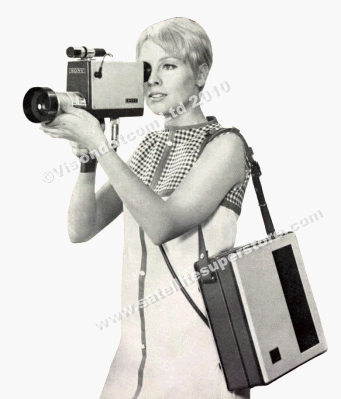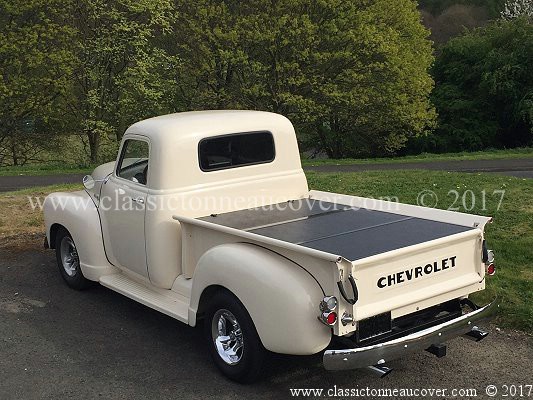What does a satellite system consist of?
1. A satellite receiver.
2. A dish kit consisting of a dish, an LNB (low noise block - see below) and a wall mount.
(mounts the dish on the wall.)
3. Cable and connectors that connect between the dish and receiver.
(Some fixed dish systems may use more than one LNB on a bracket.)
(Motorised systems use a different type of receiver and a motor bolted to the back of the dish.)
All systems use a simple arm-chair remote control method of selecting channels.
4. Some satellite systems may also need methods of decoding scrambled channels.
i.e. cards and cams (see below for more details)
The satellites are all in the southern sky and need a clear line of sight from the dish
Just like light, the signal will not go through solid objects, however, again, just like
light, it will go through glass (with a small amount of attenuation.)
What is an LNB ?
An LNB is the box of electronics on the end of the dish boom arm. It acts like a aerial masthead
amplifier. The signal (microwaves) reflect off the dish and into the feedhorn to the LNB.
Here it is amplified and the frequency is lowered. The lower the noise figure the better.
i.e. in simple terms, it pulls in the signal better. The signal is then sent down the coaxial cable to the
satellite receiver. Quality digital cable should be used. (not CT100 or RG6)
See our
Satellite Cable for good digital cable.
A universal LNB covers the KU band from 10700 to 12750Ghz with LO frequencies of 9750 and 10600.
There are
Single LNBs, Twin
LNBs, Quad LNBs, Octo
LNBs and
Quatro LNBs. Single have one output,
twin - two outputs, quad - 4 outputs and Octo - 8 outputs. All outputs are the same and are equivalent to
a single LNB. A twin LNB could be used for two single tuner satellite receivers or a twin tuner satellite receiver
Quatro LNBs have 4 outputs and they are all different. Quatro LNBs can only be used with
multiswitches.
There are also 40mm clamp LNBs and C120 LNBs. This refers to the way they fit on a dish. A 40mm LNB has an
integral offset feedhorn and fits to the most common types of offset dishes.
C120 flange LNBs fit on a separate feedhorn and could be used on either offset or prime focus dishes.
They are usually used on specialist high quality dishes.
Both 40mm and C120 LNBs could have single, twin, quad or quatro outputs.
At the moment only 40mm LNBs have octo outputs.
Using a quatro LNB and a multiswitch it is possible to have many more outputs. Even 32 outputs or larger.
A
Sky mini dish LNB uses a fixing that is none standard and a tongue fits into the end of the boom
arm
To find out more about LNBs and how the perform go to
Getting More Signal.
How big a dish do I need?
For Sky TV a mini dish works but a 60cm gives "all weather" capabilty.
For a 2 or 3 satellite system, e.g. Astra 1, 2 and Hotbird an 80 or 90cm is recommended from the UK.
For motorised use, good results can be obtained from a number of satellites with an 80cm dish
in the UK, even better results are possible with a 90cm or 1.0m dish. These provide
significantly more signal and all-weather capability from most satellites.
For dish sizes for Sky TV from Spain see
The "Sky in Spain" Page
For dish sizes for Sky TV from France see
The caravan Page
Also check out satellite footprints at www.lyngsat.com
About digital satellite. Free to air and cams.
The most common digital systems are MPEG 2 (standard definition) and MPEG 4 (high definition).
Digital receiver are either free to air, Free to air with an embedded cam (decoder) or free to
air and with 1 or 2 Common Interface (CI) CAM slots. Some receivers have embedded cams and 2 slots.
A CAM is a Conditional Access Module (equivalent to an old analogue decoder.)
A motorised system once again offers the most upgradable options for the future as
channels that can be decoded using the CI system are available from many satellites and
a motorised dish is required to find all of these thousands of channels. Smart cards for
some digital channels are also required. The card slides into the CAM and the CAM into
the receiver. If the receiver has an embedded cam, the card slides straight into the
card reader. 80cm, 90cm & 1m dishes are usually big enough for most digital channels.
Original cams and cam emulators.
There are two types of CI cams,
Original cams. E.G. Irdeto, Via Access, Conax, Mediaguard (Seca 1 and 2), Cryptoworks ... etc.
Cam emulators, E.G. Magic, Matrix, Axis, Dragon, Diablo .... etc.
They can take the form of separate CI cams or embedded cams.
When an original official card is used (E.G. foreign channels and other official cards) an original
CAM should be used - not a cam emulator if trouble free viewing is required.
Cam emulators are used by people who want to load them with software "patches" that they find on the
internet but often many of them will emulate many CI scrambling systems in the one cam. They may work
fine with an official card but often they will not "kick start" an official card on a years
subscription and if the card were to go off during the year (this cam happen if a security upgrade
code is not received due to not viewing the channel for a while) they often will not re-start the card.
Therefore for computer related uses they may well be fine but they are far from ideal with official cards.
Technomate do a number of receiver with a "multi cam" systems embedded in the card reader. They read most systems.
i.e. This cam is supposed to work on many systems with official cards. From feedback we have found that it
works well. See
the Technomate page.
Also note that there can even be problems with official cams mainly in the Cryptoworks system.
Here the card provider can match the card number to the serial number of the cam and so any cam will not work.
One way round this is to use a Technomate 5400. with embedded multicam
The embedded cam seems to work with most Crypoworks cards.
Can one satellite channel be recorded while watching another?
You have to be careful of the copyright laws here but some people participate in
"Time Shifted Viewing" using a hard drive. or watch one channel and record another.
This is possible with
twin tuner receivers.
There may also be the need to watch one channel in one room and another in another room. This is
possible with the addition of a second satellite receiver and a TWIN LNB fitted to the dish.
OR a satellite receiver containing twin tuners. For Sky TV a Sky + can be used (see
Sky+) to
record one channel while watching another but an additional receiver would be needed
to watch two channels in two different rooms. For free to air satellite or CI channels
a twin tuner CI receiver can be used. Or for Freesat, the
Humax HDR is ideal.
Advice on recognizing quality products that work well.
Satellite Dishes.
Make sure you know the make before buying the dish. Well known brand names like Triax, Orbital
or Andrews are very good. They are from large well respected manufacturers. If a dealer does not
specify the make of the dish, it may be a cheap inferior product.
Motorised dishes.
There are two types of motors. Diseqc motors and 36 volt motors.
36 volt motors are designed for larger dishes. They inject more power down a separate cable.
We would recommend a Diseqc motor on dishes up to 90cm steel or 1.0m Aluminium as long as the
1.0m dish was not in a very exposed location. A Sheltered location would probably have a wall behind it
An exposed location would be a high pole above the gutter.
There are Diseqc motors with nylon gears and Diseqc motors with metal gears.
There is nothing wrong with nylon gears. Some big 36 volt motors on 2,4m dishes use nylon gears.
They are very quiet and strong. We have sold the Technomate 2100/2200/2300 with nylon gears
for many years with virtually no problems at all. Never see them again. Very reliable.
Some Diseqc motors use metal gears. Since a Diseqc motor cannot be made any larger as only the LNB
current is available to drive it, it can be made a little stronger with metal gears but they are a little noisier.
For that reason we would recommend Diseqc motors for 1.0m and 1.1m dishes.
For 1.2m and larger dishes, 36 volt motors should be used.
The Technomate TM-2300 and TM 2600 motors
The 2300 uses nylon gears and the 2600 uses metal gears.
Compared to other Diseqc motors, there is no noticeable play in the gearing in Technomate motors.
They also tend to be a little faster. They hang from above (like an elephant trunk) which makes
installation easier.
Wall mounts.
Apply the same quality logic to the design of the very important wall mount. Unless a company
manufacturers their own (purpose built for satellite dishes) wall mounts, most commercially
made units are also very poor because they are designed for aerials not dishes. We have been
to countless insurance claims. Most commercially made wall mounts are designed for aerials not
dishes and some that are designed for dishes are not strong enough to put and 80cm on.
Mounts should be big enough to cover a large area of brickwork. Our own wall mounts for 80cm to 1.2m
dishes are held up with 10 coach bolts into the brickwork. There are two or three points that should
make alarm bells ring. A "Free" wall mount with the motorised system. This is likely to be useless.
A wall mount with only 3 or 4 bolt fixing. OK for a 60cm or 80cm fixed dish but nothing larger.
The final factor to check is the thickness and material of the pole. It should be Steel not alloy
and the steel should be at lease 3mm thick for 1.2m dishes. We have seen 1mm thick poles snap in high
winds even on an 80cm dish and the whole rig on the ground. To conclude, use your judgment to choose
well engineered heavy-duty products. Cheap junk will always cost you more in the long run. If a dealer offers a
complete (e.g.) Technomate system or Topfield system remember that only a Technomate and
Topfield receiver may be included. The dish and motor could be made by anyone and the dealer
could be including junk to get the price down. Never buy a system without knowing the
make of every component in it. Would you buy a Vauxhall Vectra car and caravan combination
without first checking what kind of caravan is included in the deal? Dishes with motors
start at about £120 and go up to £400 for an 80-120cm. If the dealer does not say what
kind of dish and motor is included with the package, do you think it will be a good one?
or (more likely) a cheap piece of junk so that a tempting price can be offered? These
dealers rely on the fact the customer does not know enough to tell the difference until it is
too late. They are the same type of dealer that are difficult if not impossible to deal
with once you have spent your money. There is nothing wrong with comparing prices as long as
you know exactly what you are getting for your money and you have avoided dealers where back
up in the future may be a problem.
What is a motorised system ?
It's a system that offers hundreds of channels (typically about 8000+) by armchair remote control.
Channels from many satellites. Many are scrambled and may need subscription cards but around 1000+
channels are free to are (clear - Europe). There are English speaking channels and the ability to
watch the world. Also if a channel moves to another satellite simply move the dish.
Choosing a motorised system, read on,
As an independent dealer with no connections with any manufactures we can offer unbiased advice. We do not
stock products we have found to be of poor quality or do not offer good value for money.
We believe very strongly in heavy duty products with proven reliability. A motorised system comprises
a receiver, a dish, a motor an LNB and a wall mount.
The receiver may be standard definition or High Definition. HD receivers also work in SD.
HD receivers tend to be more expensive but if you have an HD TV they are a better option.
Some receivers offer recording hard drive options.
The
Technomate 5400 is a very good SD receiver for motorised use and is not expensive.
The
Technomate 6900 and
Lyngbox both are excellent HD motorised receivers.
Wall mounts.
Why are our mounts "Primesat Vision" range different?
If you see anyone offering a "free" wall mount with a motorised system, beware! They are not going to give
away anything that is decent and the whole rig could come down in the wind. Dishes in more exposed locations
need a substantial strong mount! Our wall mounts usually have
450mm
(18") stand-offs for south (ish) facing
walls (For 80 - 1.1m dishes)
or a
550mm
stand-off for
1.25m
or
1.3m
dishes. There are also
300mm,
(12")
450mm
and
550mm
stand-offs for poles above the gutter (east west or north facing walls), For east or west
facing walls, clearing the gutter is needed so the dish can turn without hitting the wall. Our "
Primesat Vision"
wall mounts and ground stands are made in our own workshops and are made with thick steel. Galvanised
masts
are made of 3.2 mm steel (or thicker). Galvanized clamps are included. Most
ground stands
and wall
mounts are black They are etch-primed and stove baked in an oven. Our wall mounts are not compromised by
designing them to be flat packs (although bolt together versions are available, when bolt-together is chosen,
it is the same mount and due to the bolt-together design rigidity is NOT compromised). Fully welded is a
cheaper but very good option. Ground stands are also fully welded. Above 1.0m high, (e.g.
1.25m)
stands
are bolt together due to the size of the stands. 1.0m stands have a bolt-together option and come with
adjustable feet
so the pole can be made plumb. Nuts top and bottom on the studs adjust for plumb with
a spanner. This makes for very easy setting up. We designed our wall mounts and ground stands when we
started in 1991 and since then they have been "fine tuned" and improved. From the outset they were
designed for satellite dishes and built to heavy duty high standards. We believe "the house will fall down
before our wall mount would fail", providing they are properly fitted and used on the correct size of dish.
The
south facing
mounts are bolted with 10 bolt fixing, 4 to the left, 4 to the right and 2 at the bottom.
The
"
above gutter mounts"
are 20 bolt fixing. (They are basically 2 south facing mounts with a long pole).
These mounts are very strong and are designed for satellite dishes. Many commercially made mounts are
designed for aerials and many satellite dealers use them for dishes since they do not have the resources
to make decent heavy duty mounts themselves. Typical aerial mounts are called "T & K" mounts. We would
not recommend this type of mount for satellite dishes. Some mounts are not even as good as T & Ks!
The wind can push a ship around the world so why take a risk ? Our mounts and stands may cost a little
more but at least they take away the worry during gale force winds. Our
"
above the gutter"
mounts
usually these use a 2m pole. The
76mm diameter above the gutter mounts
have a 3m pole option. We also
sell "mounts without poles", this can make international shipping cheaper. We sell the poles
(
masts)
separately and we manufacture
pole adapters.
Pole adapters
are useful for converting an
existing ground stand to the correct pole diameter for a different dish or motor.
Note - we reserve the right to vary these specifications.
See all of our wall mounts, ground stands, masts, and pole adapters on the
wall mount menu page.
Finding a good dealer.
Did you know there are some dealers who have a stock answer to technical questions?
That answer is
"READ THE MANUAL".
If price is the only consideration, sooner or later you may find "box shifting" dealers like this.
If so we wish you luck. You will need it! Why not check out our
Support Page
It is not easy to find a good dealer but there are a few suggestions to help you.
1. Has the dealer been authorized by any manufacturers to sell their products? Ring the manufacturer,
they may have a list. But it must be a list due to vetting. Many lists are not due vetting schemes for most products.
2. Check if the dealer have any qualifications or certificates of membership of professional
associations? Be careful with some qualifications as a Sky Digital qualification means a dealer has
been trained to fit Sky Digitals. It does not mean they know much about motorised systems.
3. How long has the dealer been established?
This in itself is not a sign of a good dealer but it helps build up a picture.
4.Can you get hold of someone on the end of the phone or via e-mail that understands technical questions
at most times of the day? Or, do you get an answerphone, or a salesperson that has no idea what they are
talking about? If this is the case when you enquire about products then it will certainly be the case
when you have paid your money. You may find (when it is too late) that no amount of cost cutting offers are worth this
kind of aggravation. Check also whether e-mail back up is also available. In particular do they answer
there e-mails? Many do not!
5 Does the dealer sell products that look like they are heavy duty? A good sign is if the dealer
manufactures their own heavy duty
wall mounts and ground stands.
Let us consider how we at measure up against these guidelines.
1. We are authorized dealers for many of the main manufacturers
2. The MD has a degree in Electronics. We have "Eurosat" motorised qualifications dated
1989. We have Sky Digital certificates. As far as professional associations are concerned we are
"Master Members of the Institute of Videography" We are the producers of The Motorised Satellite training videos.
These have been recommended by BBC training
We are authorized suppliers to the BBC.
3. Vision was established in 1991, 18 years ago. AVS started in 1989
(and is still in existence, i.e video production) and in those early days satellite was
part of AVS. Hence the satellite qualifications in 1989.
Our first web site dates back to 1998 and
www.satellitesuperstore.com with a shopping cart started in 2000.
4. Advice is available during the day and on Saturdays on the phone and after hours via e-mail
We do not close for annual holidays although we do close on bank holidays.
5. We only sell quality products which is why there are omissions in our catalogue.
As independent satellite dealers we are free to select products that we believe in and that we can
fully support. In addition we manufacture our own heavy-duty wall mounts and ground stands.
An interesting letter from a customer who commissioned "an installer from Hell"
Here is an interesting letter we received on the 27th March 2000
Dear Sir,
You did a site survey for me, (Vision note - about three weeks earlier - we used to install in those days)
and gave me a price for a satellite installation, the following day a friend at the pub said
"don't get a Manhattan receiver" I asked why, he said they were prone to faults,
(Vision comment. From all of the Manhattans 2500s we have sold since January 00 when it was
introduced till January 01 when it was discontinued, we have only ever had one faulty unit
which had a dry joint on the circuit board) I know nothing about them and assumed he did, he suggested a
Humax receiver. I have had that many views and didn't know whose advice to take. I plumped for the
first person in the satellite book, it was …. NAME WITHHELD…….he said he could set the whole
thing up.
First day - parts didn't turn up
2nd day - instructions didn't turn up
3rd day men didn't turn up
4th day awaiting further parts
The men could not do the job with the parts, I told ….NAME WITHHELD …to take it down and I'll forget
the whole thing, the man you sent (Vision note. We sent an engineer) knew everything and did
a good job, (Vision comment, we know everything but it was a nice compliment) it was up and
running the same day. I regret now not using you from the beginning. I am sending you the Humax
receiver to tune in (Vision note i.e. download all channels and provide a print out of the lists)
he (Vision note, "he" the sales person from the mail order company) said you would come and
set the whole thing up, he said you would bring a scart lead, any tuning in fee you require,
he said he would take care of the cost as I have paid the original price, sorry for any inconvenience
You can arrange a time that suits you on the above number.
Yours faithfully
NAME WITHHELD
Tyne and Wear
Vision comments,
There are a number of issues to address as a result of this experience. Let us first explain that
we were contacted by this non-local mail order company who we would like to stress ARE a
reputable company and were very willing to pay us to sort out the mess. Unfortunately they had
commissioned a local North East company (who often have an advert in the magazines) to install the
system and this company made a complete "dogs dinner" of the whole installation. Whether this was
malice or complete ignorance and lack of ability is uncertain. Let us tell explain what our
engineer found when he arrived at the customers house.
1. The Sky digital dish should have been fixed to the mount by 4 bolts. It was loose due
to being held by one bolt and a bent nail!
2. The other end of the signal cable had no F connector fitted and was not plugged into the Digibox.
3. The motorised dish was going east when west was pressed on the remote due to the cable polarity
being the wrong way round.
4. The motorised dish was not picking up any satellites, as it was not tracking the arc.
When it should have been pointing at 1 degree west (i.e. in the Apex position) it was pointing at
10 degrees east. This means it was "out by a mile!"
5. The 36V motor cable should have had a reasonable rating. (e.g. 5 amps) They had used the
thin BT indoor telephone cable! Anyway our engineer sorted all of the faults and both the
Sky digi and the analogue motorised system were working within one and half-hours.
The customer was however still left with a number of problems. We were not aware of the
fact that a Humax digital had to be connected. (Indeed the mail order company had not asked us to
set up a Humax) This is why we had to return. The mail order company then asked us to program
it and install it. The biggest problem is the wall mount. On The Motorised Satellite Video Volume 3
we show the same commercially made wall mount made of light weight thin materials with provision
for only three coach bolts. One to the left, one to the right and one to the bottom.
(Vision mounts use 10) we also show on the video where the mount has sheered in the wind since it was
part of an insurance job last year. We have been asked to sort out two insurance claims from
people who have used this type of mount and then had it break in high winds.
Now let us examine why we recommended a Manhattan and not a Humax.
You probably know from looking at other pages on this site that we sell and have a very high regard
for the Humax receivers. The fact is that the Humax makes an ideal addition to an EXISTING
analogue motorised system. The disadvantage however is that two remotes have to be used. One
to move the dish on the existing system and then one to select the channel on the Humax.
If you are starting fresh why buy this inconvenience? Better to buy a fully integrated all in the
one box, all on the one remote, reliable, easy to use The Manhattan analogue and digital
motorised receiver contains a full 5A hardware positioner. (so does the Strong and the Echostar)
Even though we were able to get everything working for this customer, what was he left with?
A wall mount, which could come down in high winds, a universal fit small dish motor, poor
wiring, and an obsolete analogue motorised receiver with a separate digital and two remote controls.
Update Nov 01. The Humax can now be used with a V Box (see page link below) to make it fully
automatic on one remote and the V Box injects 3 A so that heavy duty motors can be used.
We really don't buy the man in the pub story. A more likely scenario is that price was his
only consideration. Did he "save" £100.00. Perhaps he paid £500 instead of £600 for the goods
and installation? What really happened was that instead of saving £100 he wasted much of the £500!
Quite frankly the Humax is a good machine but the rest was junk.
Update 2009 - Since for quite a few years now we have been 100% mail order we have put into place
a great deal of support for customers who would like to fit the system themselves. With our help
everyone succeeds in the end. (Some more quickly than others) No prior knowledge is needed.
No prior Knowledge is preferred! Prior Knowledge can result in customers not listening to us.
You ONLY have to follow instructions. It is highly likely that you will do a better job than
many (expensive) installers. You will have the satisfaction of doing it yourself and any future
adjustments are then easy. No need to, again, call anybody out to sort it out. See our support page at
Advice Page 4 (The support we give you)












